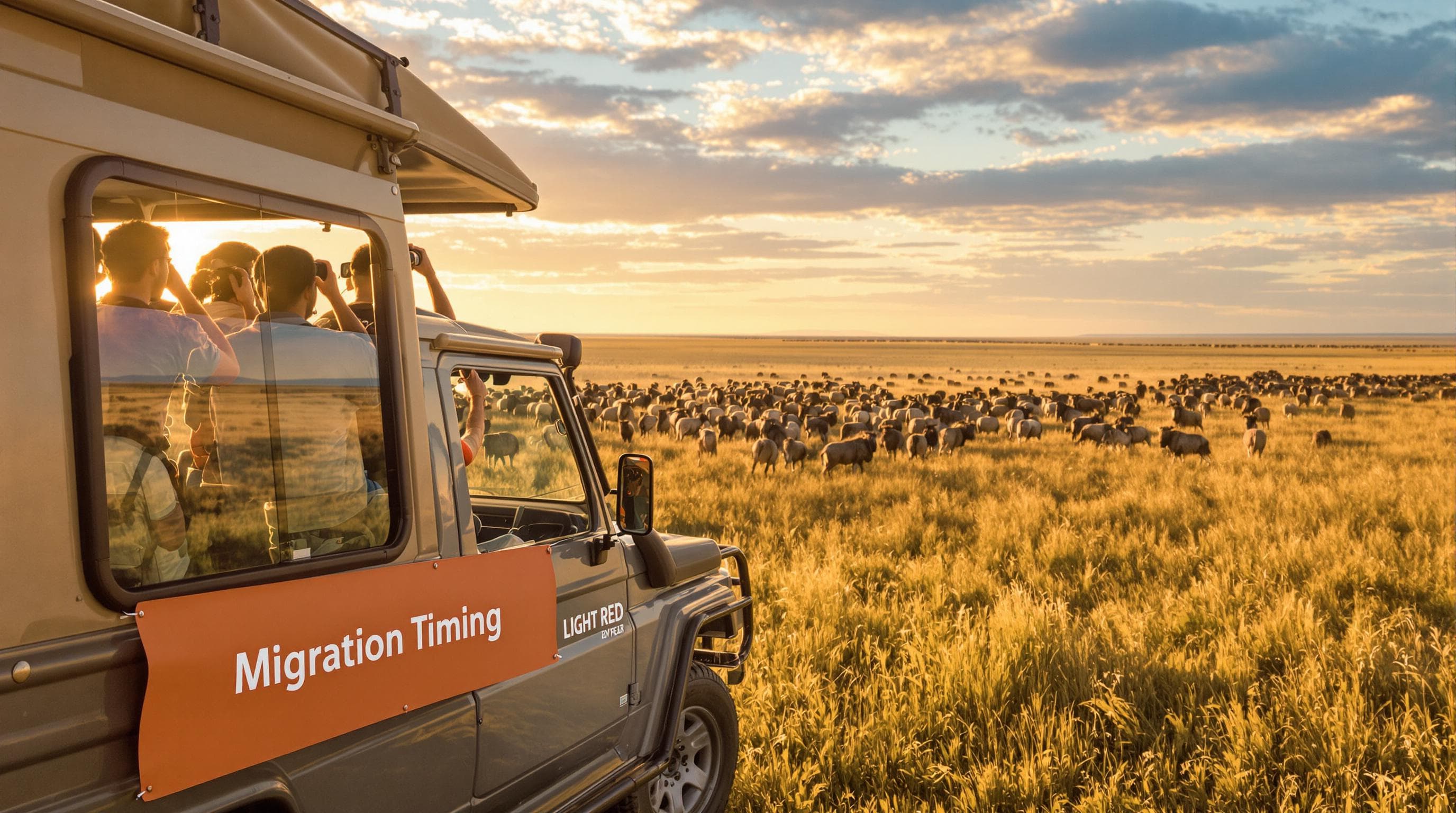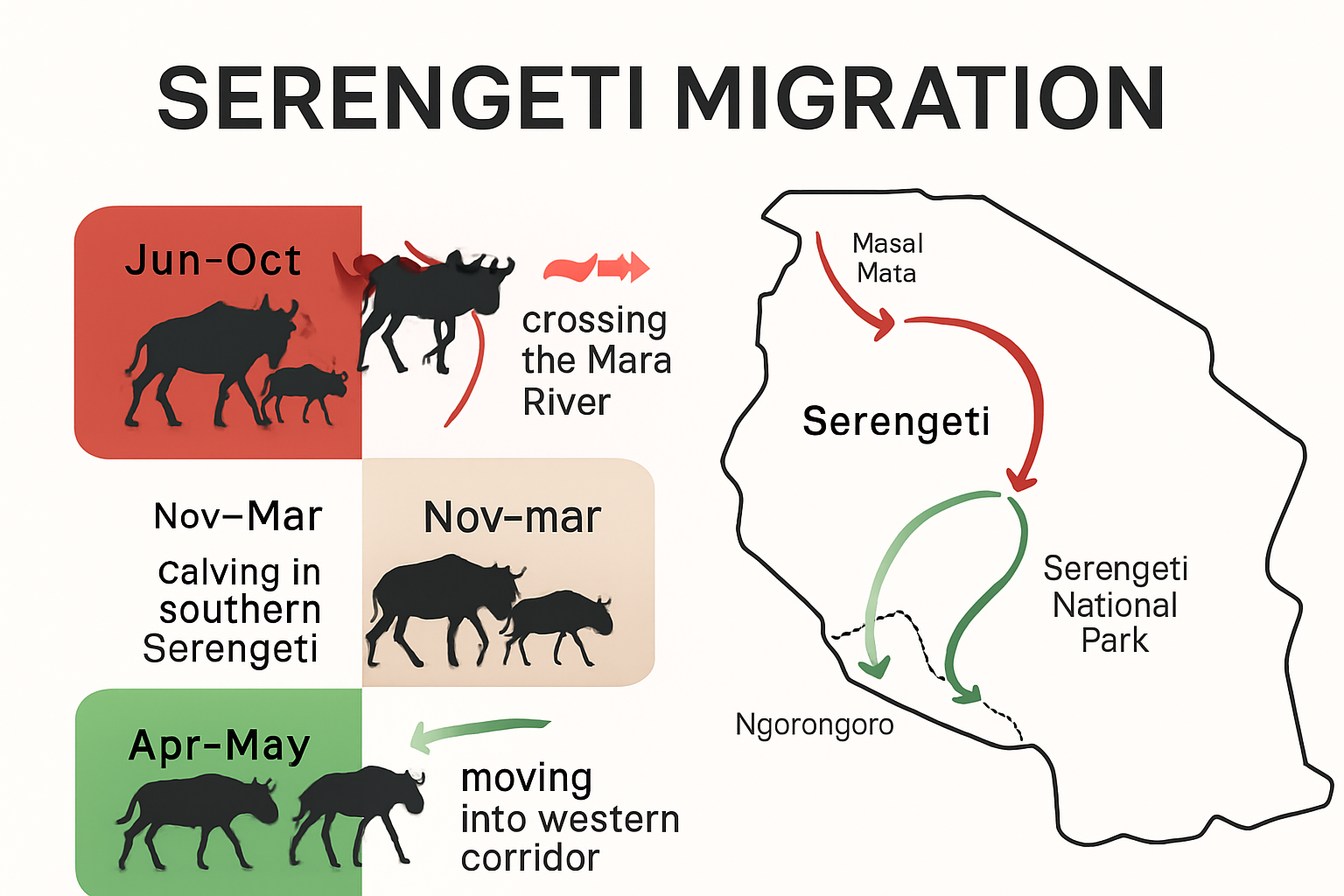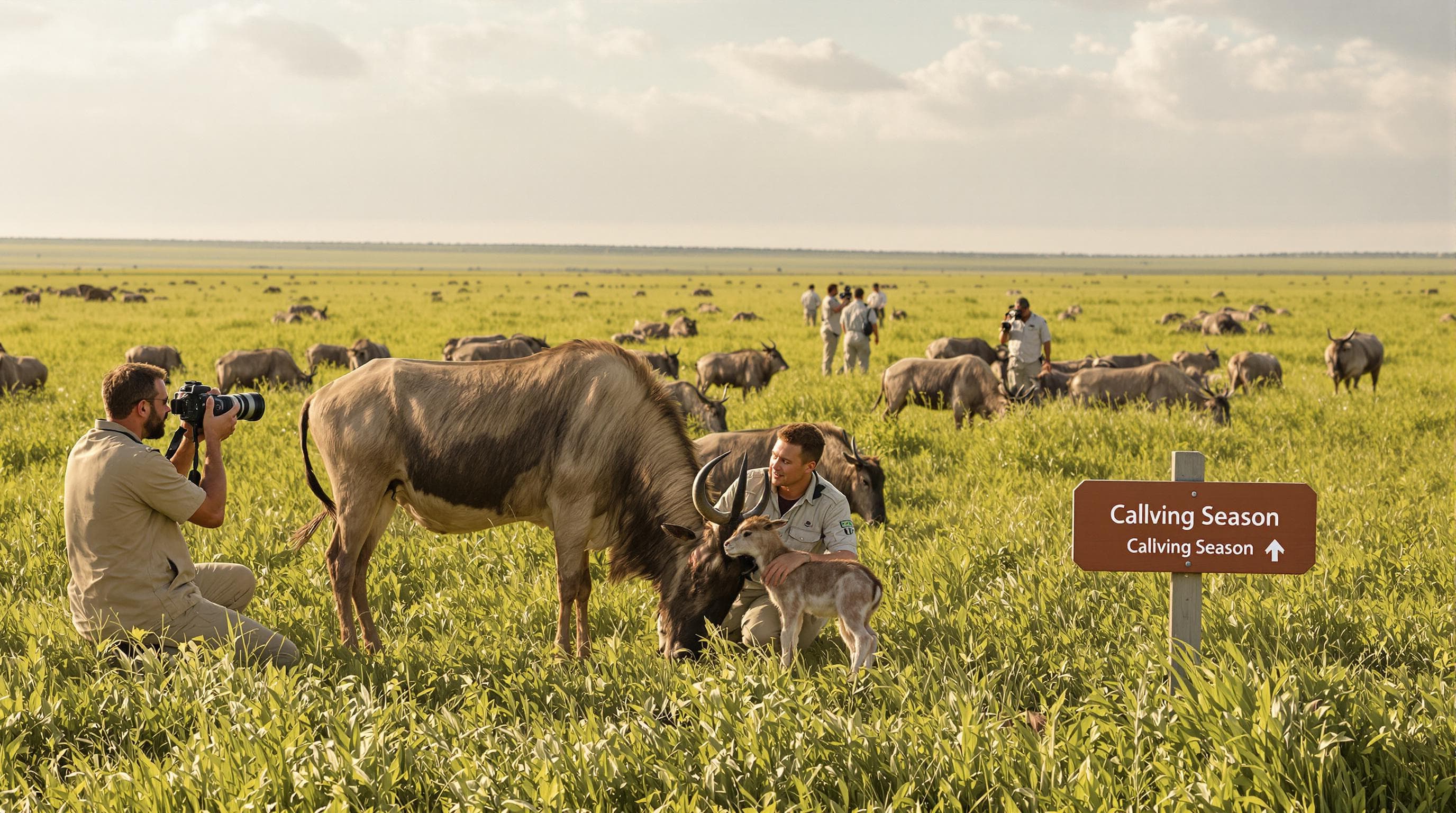Best Time for Serengeti Migration: Your 2025 Safari Guide
Full Disclosure: Our AI Assistant Writes These!
While we're out in the bush tracking leopards, dodging elephants, and trying to get the perfect sunset shot, our trusty AI companion is back at camp, diligently crafting these blog posts. Don't worry though - it's been trained on years of real safari experiences and only occasionally suggests that tourists should pet the lions. (Please don't pet the lions. The AI was joking. We hope.)
The real reason? SEO loves fresh content, and we love fresh adventures. So while our AI handles the keywords and search rankings, we're out there finding the next hidden waterhole, secret viewpoint, or that one tree where the leopards always hang out. Win-win, really!
Best Time for Serengeti Migration: Your 2025 Safari Guide

The Serengeti migration draws travellers from all over the world. Every year, over 1.5 million wildebeest and thousands of zebras trek across nearly two thousand kilometres in search of fresh grass and water. Most assume the greatest challenge is just catching a glimpse of these herds. Turns out, the real trick is picking the precise moment—because what you see changes completely depending on when you go.
Table of Contents
- Understanding The Serengeti Migration Cycle
- Month-By-Month Guide To Migration Hotspots
- Choosing The Right Time For Different Travellers
- Insider Tips For An Unforgettable Migration Safari
Quick Summary
| Takeaway | Explanation |
|---|---|
| Migration Cycle Timing is Key | Understanding the migration cycle from December to November is crucial for effective safari planning, with distinct phases including calving, river crossings, and peak migration moments. |
| Best Months for Wildlife Viewing | Optimal months for witnessing dramatic wildlife events include January-March for calving and August-September for river crossings at the Mara River. |
| Budget Considerations for Travel | For budget travellers, the shoulder months (April and May) offer lower prices and fewer crowds while still providing memorable wildlife experiences. |
| Essential Gear for Safari | Essential items for a successful safari include high-quality camera equipment, lightweight clothing, and comprehensive medical kits to ensure comfort and safety. |
| Advance Booking is Crucial | It’s recommended to book accommodations and safari packages at least 9-12 months in advance, especially during peak migration periods, to secure the best experiences. |
Understanding the Serengeti Migration Cycle
The Serengeti migration represents one of the most extraordinary natural phenomena on our planet, a remarkable annual journey that transforms the African wilderness into a breathtaking spectacle of wildlife movement. This epic trek involves over 1.5 million wildebeest, alongside hundreds of thousands of zebras and gazelles, traversing an immense landscape in a continuous cycle of survival and renewal.

The Annual Circular Journey
The migration is not a simple linear movement but a complex circular pattern driven by seasonal rainfall and grassland conditions. Animals follow an intricate route covering approximately 1,800 kilometers through Tanzania and Kenya, seeking fresh grazing lands and water sources. National Geographic describes this journey as the most extensive terrestrial mammal migration globally, highlighting its unparalleled ecological significance.
The migration’s rhythm follows predictable yet dynamic patterns. Wildebeest herds begin their journey in the southern Serengeti’s short grass plains around December, gradually moving northwest through the ecosystem. By June and July, the massive herds reach the treacherous Mara River crossings - a dramatic stage where thousands of animals risk their lives navigating crocodile-infested waters.
Survival and Ecological Dynamics
Survival during the migration is a complex interplay of strategy and instinct. Predators like lions, cheetahs, and hyenas trail the herds, creating a dynamic ecosystem where each movement represents potential life or death. World Wildlife Fund notes that approximately 250,000 wildebeest perish annually during this journey, primarily from predation, drowning, or exhaustion.
The migration is not merely a movement of animals but a critical ecological process. As herds graze, they stimulate grassland regeneration, create nutrient pathways, and maintain the delicate balance of the Serengeti ecosystem. Their movement distributes seeds, supports scavenger populations, and represents a complex web of interdependence that sustains the entire landscape.
Understanding this remarkable cycle requires appreciating its nuanced complexity - a testament to nature’s extraordinary capacity for adaptation and survival. Learn more about our expert safari planning for witnessing this incredible migration.
Month-by-Month Guide to Migration Hotspots
Tracking the Serengeti migration requires precise timing and understanding of the herds’ intricate annual movement patterns. Each month presents unique wildlife viewing opportunities, transforming the landscape into a dynamic theater of natural spectacle. African Wildlife Foundation emphasizes that successful safari planning hinges on comprehending these seasonal shifts.
Southern Serengeti: Calving Season (December - March)
During the initial months, the southern Serengeti plains become a nursery of extraordinary proportions. Approximately 8,000 wildebeest calves are born daily during this period, creating a remarkable landscape of new life. Scientific Research in African Ecosystems reveals that this concentrated birthing period serves as a survival strategy, overwhelming predators with an abundance of vulnerable young.

The short grass plains around Ndutu provide critical nutrition for nursing mothers and newborn calves. Predators like cheetahs and lions congregate, creating intense hunting dynamics. Photographers and wildlife enthusiasts find this period particularly compelling, with unprecedented opportunities to witness birth, survival, and the raw energy of natural selection.
Western Corridor and Grumeti River Crossings (April - July)
As the dry season intensifies, herds begin migrating northwest towards the Western Corridor. The Grumeti River becomes a critical and dangerous crossing point. Massive crocodiles lie in wait, creating one of the most dramatic wildlife spectacles on the planet. Research indicates that during these months, approximately 3,000 to 5,000 wildebeest may perish during river crossings.
The landscape transforms dramatically during this period. Grasslands turn golden and dusty, compelling herds to seek more favorable grazing and water sources. Predator populations surge, taking advantage of exhausted and vulnerable animals attempting treacherous river crossings.
Northern Serengeti and Masai Mara: Peak Migration (August - November)
The final stages of migration bring herds to the northern Serengeti and Kenyan Masai Mara. Here, another series of river crossings awaits at the famous Mara River. These crossings represent the most iconic and photogenic moments of the entire migration cycle. Wildlife Conservation Research Center notes that these crossings involve up to 1.5 million animals moving in synchronized, almost choreographed movements.
During these months, visitors can witness extraordinary scenes of survival - thousands of wildebeest charging across treacherous waters while crocodiles and other predators create a gauntlet of challenges. The landscape becomes a living, breathing ecosystem of constant movement and survival.
Explore our expert safari packages designed to capture these incredible migration moments.
To help you visualise how the migration changes throughout the year, here’s a table summarising the migration phases, locations, and key highlights by season:
| Season / Months | Main Location | Key Highlights |
|---|---|---|
| Dec – Mar (Calving) | Southern Serengeti (Ndutu plains) | Mass calving (~8,000 calves/day), predator activity |
| Apr – Jul (River Crossings) | Western Corridor, Grumeti River | Grumeti River crossings, golden grasslands, predators |
| Aug – Nov (Peak Migration) | Northern Serengeti & Masai Mara | Mara River crossings, herds in Masai Mara, drama |
Choosing the Right Time for Different Travellers
Selecting the optimal time for a Serengeti migration safari depends on individual preferences, travel styles, and specific wildlife viewing goals. Safari Professionals International highlights that each traveller segment experiences the migration uniquely, making timing a critical planning consideration.
To help different types of travellers decide the best migration timing, see the comparison below outlining recommended travel times and benefits for each traveller type:
| Traveller Type | Recommended Months | Main Benefits |
|---|---|---|
| Budget | April – May (Shoulder season) | Lower prices, fewer tourists, lush landscapes |
| Photography/Wildlife | Jan – Mar (Calving), Aug – Sep | Birthing drama, predator action, river drama |
| Family/Luxury | Jun – Oct (Dry season) | Good weather, comfort, reliable wildlife |
Budget Travellers and Peak Season Strategies
Budget-conscious adventurers face unique challenges when planning migration safaris. The peak season from July to October offers the most dramatic wildlife viewing but comes with significantly higher prices. Ecotourism Research Institute reports that accommodation prices can surge up to 60% during these months.
Smart budget travellers might consider shoulder seasons like April and May, when tourist numbers decrease and prices drop. These months offer more affordable rates while still providing exceptional wildlife experiences. The landscape transforms into lush green terrain, creating stunning photographic opportunities with fewer crowds competing for the best viewing spots.
Photography and Wildlife Enthusiasts
Photographers and serious wildlife observers require strategic timing to capture extraordinary moments. The calving season from January to March provides unparalleled opportunities to witness newborn animals and intense predator-prey interactions. Wildlife Photography Association recommends this period for capturing rare birthing scenes and dramatic hunting sequences.
For those seeking the iconic river crossings, August and September represent the pinnacle of migration drama. Massive herds navigating treacherous water crossings create once-in-a-lifetime photographic moments. Professional photographers often book specialized wildlife photography tours months in advance to secure prime viewing locations.
Family and Luxury Travellers
Families and luxury travellers prioritize comfort, safety, and predictable experiences. The dry seasons from June to October offer more stable weather conditions and easier wildlife viewing. Luxury Safari Consultants recommend this period for families, noting better road conditions and more comfortable camping and lodge experiences.
Luxury travellers can enjoy exclusive game drives, high-end accommodations, and personalized experiences during these months. Many premium lodges offer specialized guides who provide in-depth ecological insights, transforming a simple safari into an educational journey.
Discover personalized safari planning that matches your unique travel style, ensuring an unforgettable Serengeti migration experience tailored precisely to your preferences.
Insider Tips for an Unforgettable Migration Safari
A successful Serengeti migration safari requires more than just excellent timing - it demands strategic planning, deep understanding, and careful preparation. African Safari Experts emphasize that the difference between a good safari and an extraordinary experience lies in nuanced preparation and insider knowledge.
Essential Gear and Technical Preparation
Professional wildlife photographers and seasoned safari travelers recommend specific technical preparations for migration safaris. High-quality camera equipment with robust telephoto lenses becomes crucial for capturing distant wildlife interactions. National Geographic Wildlife Photography Guide suggests bringing cameras with at least 300mm focal length and fast autofocus capabilities to capture rapid animal movements.
Beyond photography, travelers must consider practical gear considerations. Lightweight, neutral-colored clothing, high-SPF sunscreen, wide-brimmed hats, and comprehensive medical kits are non-negotiable. Dust-proof bags for electronics, multiple battery backups, and portable charging solutions ensure technological reliability in remote wilderness conditions.
Health, Safety, and Environmental Consciousness
Migration safaris demand heightened awareness of personal health and environmental interaction. World Health Organization Travel Recommendations advise comprehensive vaccinations, including yellow fever, hepatitis A and B, and typhoid. Travelers should consult healthcare professionals at least six weeks before departure to complete necessary medical preparations.
Environmental consciousness becomes paramount during wildlife observation. Strict adherence to professional guides’ instructions, maintaining safe distances from animals, and minimizing ecological impact represent critical ethical considerations. The Leave No Trace principles apply rigorously in these delicate ecosystems, where human intervention can significantly disrupt natural wildlife patterns.
Booking and Logistical Strategies
Successful migration safari experiences hinge on strategic booking and logistical planning. Experienced travelers recommend booking accommodations and safari packages at least 9-12 months in advance, particularly for peak migration periods. Safari Booking International reports that prime lodges and specialized tours can fill up rapidly, with some exclusive experiences selling out years in advance.
Budget considerations extend beyond mere accommodation costs. Travelers should factor in comprehensive travel insurance, potential visa expenses, required vaccinations, and emergency medical evacuation services. Understanding the complete financial landscape prevents unexpected complications during the journey.
Explore our comprehensive safari planning resources to transform your migration experience, ensuring a seamless, unforgettable adventure through one of nature’s most extraordinary spectacles.
Frequently Asked Questions
What is the best time to witness the Serengeti migration?
The best time to witness the Serengeti migration is between December and November, with key highlights during the calving season from January to March, and the river crossings at the Mara River from August to September.
When does the calving season occur in the Serengeti?
The calving season occurs from December to March, during which approximately 8,000 wildebeest calves are born daily, making it a prime time for wildlife viewing and photography.
How can budget travellers experience the Serengeti migration without overspending?
Budget travellers can experience the Serengeti migration by visiting during the shoulder seasons of April and May when prices are lower, and tourist crowds are fewer, while still enjoying lush landscapes and wildlife sightings.
What essential gear should I pack for a Serengeti migration safari?
Pack high-quality camera equipment, lightweight neutral clothing, sunscreen, hats, and a comprehensive medical kit. Portable chargers for electronics are also recommended for remote conditions.
Experience the Serengeti Migration on Your Terms
Still unsure when to catch the unforgettable spectacle of the Serengeti migration? Picking the ideal time is the biggest challenge for many travellers, and the stakes feel high. Miss the river crossings and you could skip the most dramatic moments. Mistime the calving season and you might not see the surge of new life in the plains. With so many shifting migration phases and traveller needs, planning can feel overwhelming—even for seasoned adventurers.

Let Africa Awesome handle the complexity for you. Our safari experts understand every twist and turn of the migration cycle and can match your timing and interests to the best wildlife experiences. Whether you dream of family-friendly comfort, budget-friendly adventure, or capturing the iconic Mara River crossings, we help you plan the journey you actually want. Secure your spot before the peak rush begins. Start customising your unforgettable safari and trust your travel moments to the team that knows Africa best.
Begin planning today at Africa Awesome. If you want curated guidance, step through our expert process at How to Plan a Safari – 2025 Guide. Your front-row seat to nature’s greatest show is waiting.
Recommended
- How to Book a Safari: A 2025 Guide for Every Traveller
- How to Plan a Safari: 2025 Guide for All Travellers
- 8 Day Amboseli & Serengeti Trail Tour | Africa Awesome
- 10 Day Serengeti, Ngorongoro and Zanzibar Overland Tour | Africa Awesome
- Best Time to Move House in the UK: Guide for 2025 & Beyond | Schott Removals
- Prime Real Estate Locations Costa Rica: 2025 Guide for Investors – costaricaloanexperts.net